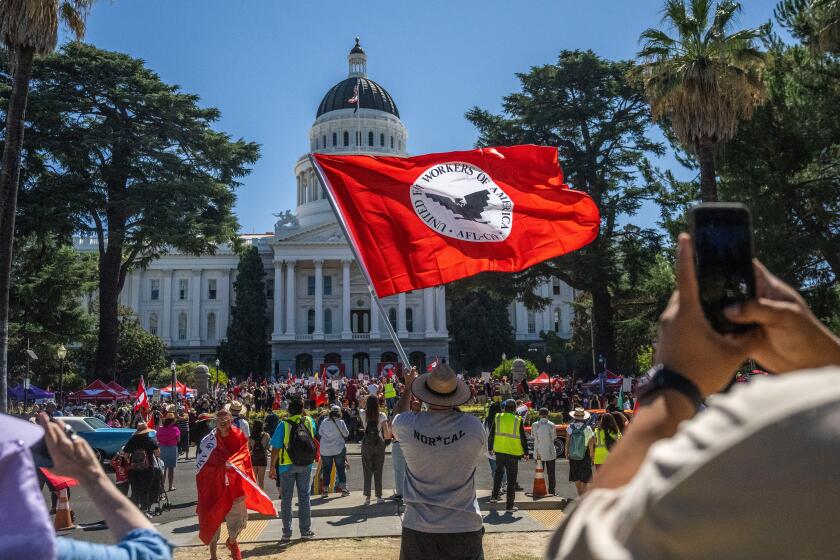PG&E; Plan to Pay Debt Has No Rate Hikes
Pacific Gas & Electric Co. unveiled a plan Thursday to emerge from bankruptcy that it says would allow it to pay creditors in full without an increase in customers’ electric rates.
The reorganization plan, filed in U.S. Bankruptcy Court in San Francisco, would split the utility from its parent, PG&E; Corp., to form two separate businesses.
The reorganization, expected to be completed by the end of 2002, calls for the Northern California utility to use cash and new borrowing to erase $13.2 billion in creditor claims.
Analysts said Thursday that the apparent smoothness of the negotiations between PG&E; and its creditors--and their mutual support of the reorganization plan--could increase pressure on Southern California Edison, which has labored since April to avoid a similar bankruptcy filing.
But PG&E;’s announcement raised immediate protests from consumer groups, which said key provisions violate state law.
Under the plan, which must be approved by U.S. Bankruptcy Court Judge Dennis Montali, Pacific Gas & Electric would transfer its power plants, high-voltage power grid and natural gas pipeline system to the parent corporation. The utility would continue to deliver electricity and natural gas to 13 million customers in Northern and Central California.
The move would allow the parent corporation to bypass state regulatory limits on how much money a utility can borrow against its assets, in effect giving it more leverage, said Ron Low, a spokesman for PG&E.;
Pacific Gas & Electric, California’s largest utility, filed for Chapter 11 bankruptcy protection from its creditors in April after piling up billions of dollars in losses stemming from a record surge in wholesale electricity prices.
Those same price pressures crippled Edison, the state’s second-largest utility.
On Saturday, the state Legislature adjourned without passing a proposed financial rescue for Edison, prompting Gov. Gray Davis to call a special legislative session next month to make another attempt.
Creditors of the Rosemead-based utility have shown increasing signs of impatience since the Legislature adjourned. Starting late last week, several groups have attempted to put together a coalition of creditors prepared to file an involuntary-bankruptcy petition against the company.
The announcement of PG&E;’s reorganization plan could “reinforce” the view of many state lawmakers that Edison’s financial problems would be better solved in Bankruptcy Court than in the Legislature, said Brian Youngberg, a power industry analyst for the Edward Jones investment brokerage in St. Louis.
“I am sure Edison creditors will be looking at this plan very closely,” said Paul Aronzon, one of the key negotiators for creditors in the PG&E; bankruptcy and an attorney who represents a group of Edison’s banks.
Edison representatives declined to comment, saying they needed time to review the reorganization plan.
The proposal calls for creditors with claims of $100,000 or less to be fully paid in cash. Most secured creditors--those that have collateral for their loans--also would be paid fully in cash. Unsecured creditors of more than $100,000 would be paid 60% in cash and 40% in bonds.
In negotiating the plan, the creditors said they were careful to structure the bonds so they could be traded as soon as the company emerged from bankruptcy, an important move that gives them a way to quickly cash out of their positions.
Robert D. Glynn Jr., chairman of PG&E; Corp., said the reorganization plan would allow the company to be accountable for its debts “without asking the court to raise rates and without asking the state for a bailout.” He said he believes that the plan will win the support of corporate credit-rating agencies and Wall Street to make the refinancing of the debt work.
Glynn called Davis to explain the reorganization plan, attempting to assure him that the utility would be able to resume its traditional role of purchasing electricity. The state began buying some power for the utilities in January after they could no longer pay their bills.
Davis Skeptical of PG&E;’s Plan
The governor, remaining skeptical that the plan would benefit the state, intends to continue efforts to win legislative approval of a plan that would allow Edison to avoid bankruptcy, Davis spokesman Steve Maviglio said.
Richard Katz, one of Davis’ advisors, said PG&E;’s proposal underscores “a number of concerns about bankruptcy.” Under the plan, state regulators would have no control over PG&E;’s hydroelectric and nuclear power plants, meaning that the company could charge high market rates for electricity that is the least expensive to generate, Katz said.
“PG&E; is putting customers at the mercy of the Enrons of the world,” he said, referring to the Houston-based energy company. “The ratepayers lose any voice.”
The reorganization plan appears, however, to have strong support from creditors.
“At times we have disagreed, but management has listened to us and has tried to incorporate our suggestions,” said Jonathan Rosenthal, the creditors committee’s lead investment banker and a member of the negotiating team. “This shows what you can accomplish when you work cooperatively toward a goal.”
Jan Smutny-Jones, executive director of the Independent Power Producers trade group, said the plan “appears to be a creative, credible and responsible approach to paying power generators, large and small, what they are owed without increasing rates for California customers.”
Under terms of the plan, the utility would pay its debts with about $3.3 billion in cash that it expects to have on hand when it emerges from bankruptcy, about $4 billion in bonds that creditors would accept in lieu of cash payments and almost $6 billion in new borrowing. Of the new borrowing, nearly $5 billion would be made by the utility.
The plan needs the approval of several regulatory agencies, including the U.S. Securities and Exchange Commission, the Nuclear Regulatory Commission and the Federal Energy Regulatory Commission.
There is a looming debate over whether California’s Public Utilities Commission has jurisdiction in the bankruptcy. Consumer groups, for example, say the reorganization plan violates a state PUC code that prohibits the transfer or sale of power plants owned by a public utility until 2006.
Commission President Loretta Lynch said any transfer of assets from the utility as part of the company’s reorganization plan would be subject to PUC review. Under state law, she said, “The PUC would have to find it is in the public interest.”
Lynch also noted that since the 1997 formation of parent company PG&E; Corp., the utility subsidiary has had to seek commission approval to sell or transfer assets.
“The parent company bails out the utility with cash, just as we have said it could and should,” said Doug Heller, consumer advocate with the Foundation for Taxpayer and Consumer Rights in Santa Monica, “but in exchange tries to steal the power plants to enable the parent company to rip off the people of California once more.”
Heller said the plan looks to be a strategy for PG&E; to bypass California law to shed the regulated portion of the business while sheltering its most valuable assets in a deregulated corporation.
Judge to Be Asked to Reject Proposal
Consumer groups will urge Judge Montali, who is overseeing the case, to reject the plan, Heller said.
Pacific Gas & Electric plans to argue that because bankruptcy is a federal proceeding, the reorganization can be completed without state approval.
“The options we had to look at were liquidation of the assets, asking the state for a bailout or restructuring and refinancing the debt based on the value of our assets, and that seemed the best choice,” Low said.
If the plan is approved by the court, Glynn will head PG&E; Corp., which will have about 6,000 employees and continue to own its National Energy Group, an independent power business that analysts say is the most valuable portion of the company.
Additionally, PG&E; would own three subsidiaries that were formerly part of the utility’s business:
* A generating company would operate the hydroelectric plants, the Diablo Canyon Nuclear Power Plant near San Luis Obispo and other assets totaling about 7,100 megawatts of generating capacity. The new company would sign a 12-year contract to sell power to the utility for 5 cents a kilowatt-hour, a price PG&E; says is well below the contracts the state has signed to purchase power from independent producers and within the current electric rate structure.
* An electrical transmission company would operate the 18,500-mile high-voltage transmission grid now owned by the utility.
* A gas transmission company would own much of the utility’s natural gas transmission business, including 6,300 miles of pipelines and three gas storage facilities.
*
Times staff writers Tim Reiterman in San Francisco, Dan Morain in Sacramento and Kenneth Reich in Los Angeles contributed to this story.







